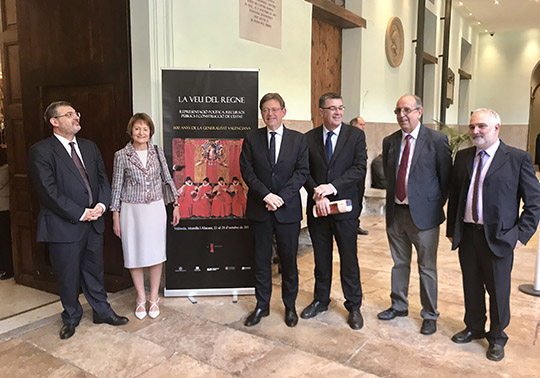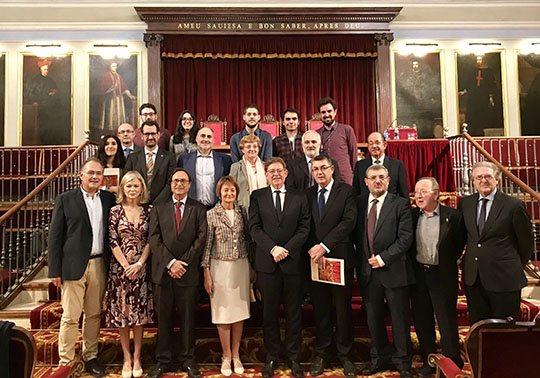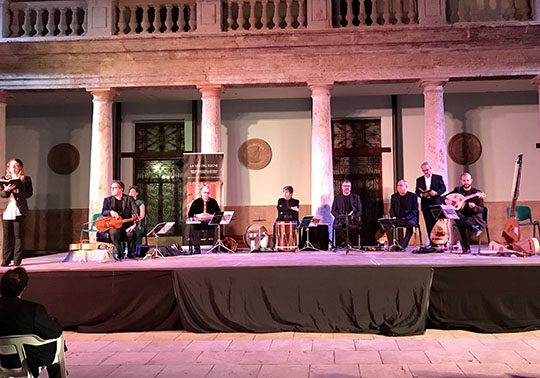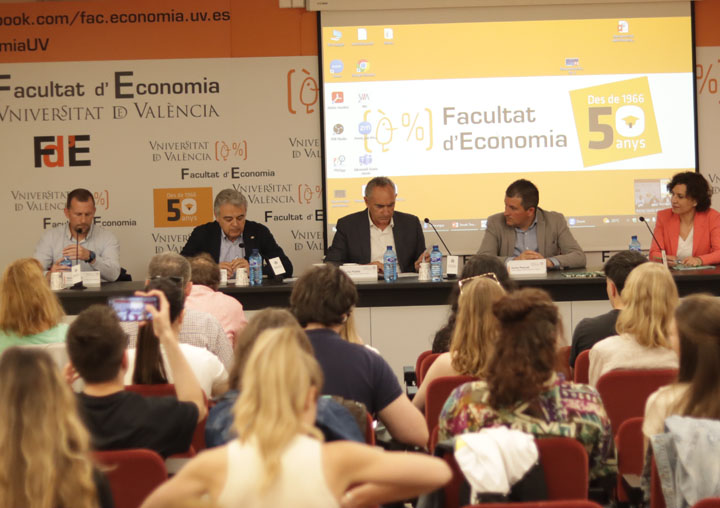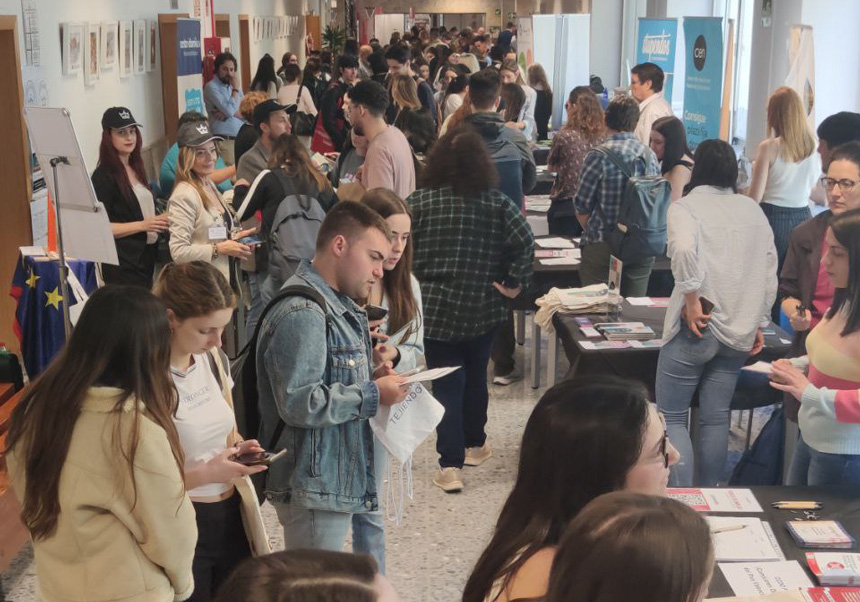International conference ‘La Veu del Regne’ has begun
- Office of the Principal
- October 20th, 2018
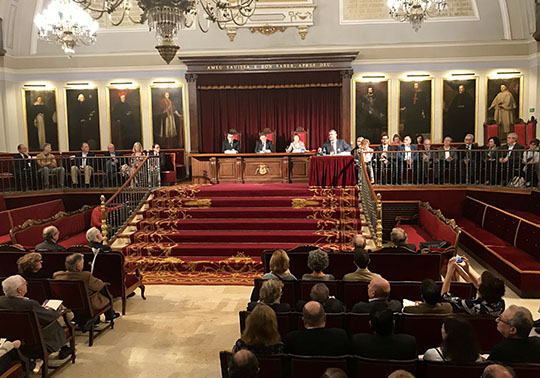
The opening of the international conference ‘La Veu del Regne’ (Catalan for ‘The Kingdom’s Voice’) took place in the Paranimf de la Nau and was presided by Ximo Puig, President of the Valencian Government; Mª Vicente Mestre, Principal of the Universitat de València; Enric Morera, President of the Valencian Courts; and Antoni Furió, Medieval History professor and president of the conference.
Under the title ‘La Veu del Regne’, more than 180 international specialists will study the 600 years of history since Generalitat Valenciana (the Valencian Government) was set up in 1418 by Alphonse the Magnanimous. The conference will travel around the Valencian Country to place value on the Valencian institution.
President Ximo Puig pointed out the Generalitat originated a decentralised model, “a federal perspective that could provide a solution to the problems that Valencian people have, such as funding.” “We need Spain to be diverse and decentralised, since territorial conflicts in Spain go beyond Catalonia”, Puig claimed.
Principal Mª Vicenta Mestre stated that “it is fair to preserve that historical memory, the recent one, the one belonging to those people that contributed to both today’s democracy and a constitutional autonomous government.” Mestre appreciated professor Antoni Furió’s labour in the conference and pointed out that this is an example of today’s institutional architecture in Valencia: collaborations between the Generalitat and the public university system.
Antoni Furió, president of the conference, gave a speech making a historical journey through the 600 years of the Valencian Government history, since its establishment in the Early Middle Ages until its abolition in 1707, and its restoration during the recent democracy and the Statute of Autonomy. Professor Furió reported that “History doesn’t provide any solutions for today’s Valencian problems, like under-funding or invisibility in the institutions, although it helps to understand why this situation has arisen.”
Vicent Soler, Valencian Minister of Finance; Gabriela Bravo, Valencian Minister of Justice; Albert Girona, Valencian Secretary of Culture and Sport; José García, CEO of Democratic Reforms and Access to Justice; and Roger Llanes, CEO of Agriculture, Farming and Fishing attended to the opening of the conference.
Many university members were also present at the event: Mª Elena Olmos, University General Secretary; Carlos Hermenegildo, vice-principal for Research; Jorge Hermosilla, vice-principal for Territorial Projection and Society; and Juan Vicente Climent, general manager; as well as Javier Palao, dean of the Faculty of Law; Jordi Vidal, dean of the Faculty of Physics; Adela Mauri, dean of the Faculty of Chemistry; Juan Monterde, dean of the Faculty of Mathematical Sciences; Rosa Mª Bo, dean of the Faculty of Philosophy and Education Sciences; Amparo Ricós, dean of the Faculty of Philology, Translation and Communication; José Manuel Pastor, dean of the Faculty of Social Sciences; Paula Marzal, dean of the School of Engineering (ETSE); Óscar Barberá, dean of the Faculty of Teacher Training; and Antoni Merelles, dean of the Faculty of Nursing and Podiatry.
The opening finished with a concert of the group Capella de Ministrers, who presented an overview of the most important music in 600 years under the title ‘Cants d’un poble per a trencar silencis’ (Catalan for ‘Traditional songs to break silences’).
Under the title ‘La Veu del Regne. Representació política, recursos públics i construcció de l’Estat. 600 anys de la Generalitat Valenciana’ (Catalan for ‘The Kingdom’s voice. Political representation, public resources and building a State. 600 years of Valencian Government’), the international conference, organised by the five Valencian public universities and sponsored by the Valencian Government itself, will run from 21 to 28 October.
With the participation of 180 specialists coming from different countries in Europe and America, the conference is structured in 16 parallel sessions covering different topics such as the origins of the institution; its relationship with the king; the representation of each estate in it; its written memory; its Treasury; its service staff; the palace that served as its headquarters; its political and legal speech that justified its measures; and, of course, the memory that helped in the restoration of the autonomous government during the last decades of the 20th century. The conference will be held in different headquarters of the Universitat de València such as the Office of Vice-Principal, the Faculty of Geography and History, the Faculty of Medicine, the Faculty of Law, as well as the Faculty of Theology and the Palace of the Valencian Government itself. It will also be brought to Morella on the 24th and to Alacant, where the closing ceremony will take place. It is expected that the conference becomes a major referent to the knowledge of the institution itself and its understanding in a context where many European regions developed similar entities.
Capella de Ministrers
Capella de Ministrers, run by Carles Magraner, is expected to offer three concerts at the La Nau Cultural Centre on 21 October, at the Sant Francesc Convent in Morella on 24 October, and at the Santa Bárbara Castle in Alacant, on 28 Ocotber. All these concerts are included in the ‘Cants d’un poble per a trencar silencis’ programme, a musical overview through 600 years of history. The show is based on the erudite Alfons Llorenç writings and aims to present the public with heritage through sounds and voices that make the memory and future of Valencian people.
Since 1987, the group, an international reference in ancient music, is developing an important research and musicological task studying the period between the Middle Ages and the 18th century. It has been recognised in the well-known International Classical Music Awards (ICMA) of 2018. The group has been playing in national and international prestigious auditoriums and has worked in the restoration of a musical heritage brought back and disseminated in 1500 concerts, a legacy that has brought 56 albums.
More information:
Images:


